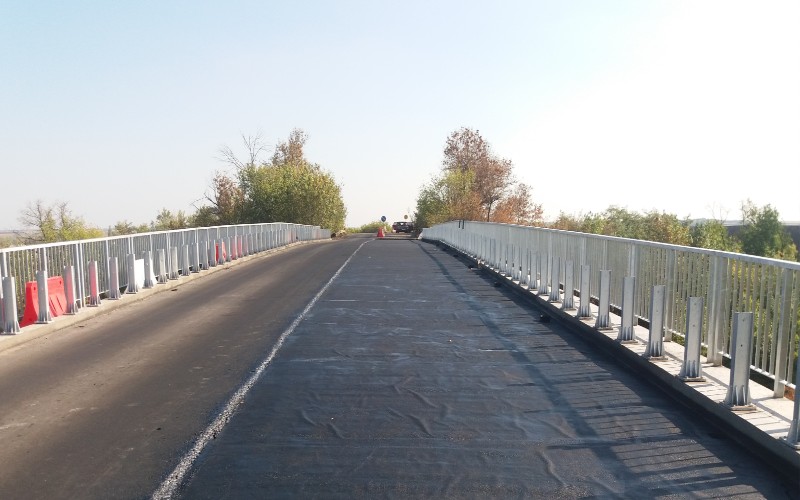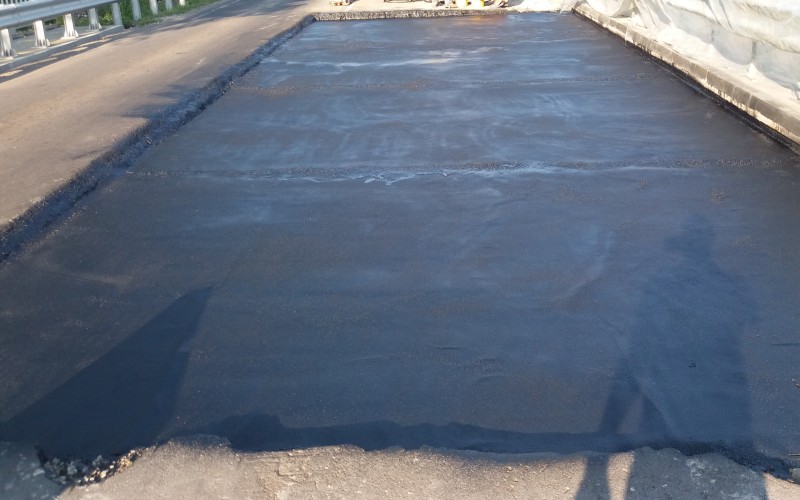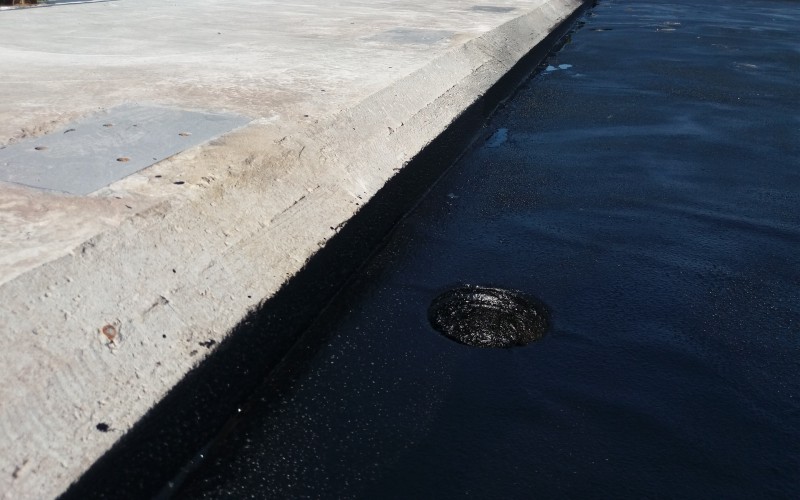Liquid rubber | Waterproofing of bridge structures
Seamless spray waterproofing for bridges
Waterproofing of bridges and bridge structures
Waterproofing of bridges and roads under asphalt
Bridge waterproofing | Waterproofing works
Sprayed waterproofing in Ukraine
Volodymyr Zelensky's presidential program "Big Construction" gave a huge impetus to large-scale work on the construction and repair of roads in Ukraine.
Along with the roads, there is also a massive repair of transport engineering structures.
Reconstruction, restoration, construction of bridges and overpasses is a very important strategic and economic resource for Ukraine.

Bridge repair in Ukraine
Construction and repair of bridges in Ukraine
In 2021, for the reconstruction or construction of transport facilities, well-known technologies are also used, such as: concrete, metal, asphalt, bitumen, wood. You can’t do without these materials, they haven’t come up with another yet.
But progress does not stand still.
Consider concrete. Due to the constant development of the construction chemical industry, there are opportunities to improve the performance of concrete mix or concrete elements.
For example, the use of effective additives for concrete : plasticizers, setting accelerators, setting retarders, anti-washout, air-entraining, waterproofing additives that increase the physical and mechanical characteristics of concrete and speed up the production process.
Ready -made repair mortars for concrete are able to quickly restore the geometry of the destroyed sections of the bridge.
Protective innovative anti-corrosion coatings for metal allow to increase the service life of the metal elements of the bridge by several times.
Waterproofing of bridges and bridge structures is also being improved and applied in road infrastructure projects.

Liquid rubber for waterproofing transport facilities
Bridge waterproofing | Waterproofing works
Waterproofing of bridges, viaducts and overpasses is a very important area and node in the overall project system.
The waterproofing of bridges with the help of a bitumen-polymer roll membrane is a legacy from the USSR.
Of course, the quality of such waterproofing materials has increased, and designers continue to include this protection system in projects for a horizontal concrete slab.
Rolled bridge waterproofing has its own advantages, in particular: low cost per square meter.
But it also has its drawbacks, for example: the presence of seams and a relatively low degree of stretching or elasticity.

Waterproofing with a roll membrane for asphalt
The elasticity and seamlessness of the bridge waterproofing is important for the entire structure:
-
year-round dynamic loads from vehicles;
- thermal expansion of materials and temperature difference from - 30 C to + 70 C.
Such loads for bridge structures require high-quality waterproofing.
By studying these processes, the world's chemical industry manufacturers have invented not just bituminous mastic, such as: MB-50, MBKG, MBG, etc.
Technologists have combined a complex of polymer additives and bitumen-based components, which together form a monolithic, seamless, elastic, temperature-resistant waterproofing system for bridges.

Seamless waterproofing of the bridge under asphalt
Liquid rubber | Sprayed seamless bridge waterproofing
Elastic, bituminous-latex, polymeric, two-component or one-component emulsion, turns into a homogeneous rubber coating , with the ability to stretch 800% or more.
Technology for applying waterproofing with two-component liquid rubber
-
Liquid, polymer-bitumen emulsion and coagulant are applied simultaneously using a double spray nozzle, on the prepared base;
-
When these two components are mixed, a coagulation process occurs;
-
As soon as the constituents reach the surface, a continuous and seamless membrane is formed, which is initially insensitive to water;
-
The stabilization process depends on the thickness of the membrane, humidity and air temperature;
-
Freezing does not disrupt the stabilization process if the coating is not subjected to mechanical stress;
- Consumption: 3-7 kg/sq.m.
Liquid rubber spraying for the bridge
Popular brands of liquid rubber
-
Masterseal 620.
-
Dorflex.
-
RapidFlex.
-
Flexigum and others.
Waterproofing of bridges in Kharkov
Advantages of sprayed liquid rubber for transport facilities
Elasticity of the sprayed membrane
Elasticity, in simple words, is the ability of a material to stretch and increase in length, and then return to its original state.
Elastic bituminous rubber, capable of stretching from 800-1800%.
This is a unique property of the material, which allows without breaks and damage:
-
withstand dynamic loads on the bridge from vehicles;
-
be used in areas where there is a high risk of earthquakes;
-
to bridge cracks in concrete, in case of their formation;
-
withstand temperature fluctuations throughout the year and day;
- applied on the base and mates, with a variety of coefficients of thermal expansion of materials.
In order for a bituminous waterproofing coating to be stretched several times from the nominal state, it is required to withstand a certain thickness of the coating.
Usually, liquid rubber when waterproofing bridges is applied with a thickness of 5-7 mm.
When stretched, the thickness of the coating decreases, a normal physical property of materials. Therefore, it is necessary to give a good thickness, so that there is where to stretch.
Seamless spray waterproofing for a bridge
When applying a bitumen-polymer emulsion in a mechanized way, there are no seams in the waterproofing coating, in contrast to a roll-on welded membrane.
First of all, water gets under the waterproof carpet, at the seams, which eventually diverge or their tightness is broken.

Waterproofing of bridges of any complexity
Temperature resistance of sprayed bridge membrane
Temperature resistance is a very important indicator in the context of the fact that hot asphalt is laid on a bituminous coating.
Liquid rubber must withstand the temperature of the asphalt, at least for a short time.
To protect the bituminous membrane during asphalt laying, thermally bonded geotextiles of 140-200 density are used.
A heat-set geotextile backing layer reduces the temperature effects of the asphalt on the protective pavement, reducing the likelihood of softening as well as mechanical damage as the paver and trucks move across the pavement.

Laying heat-set geotextile on waterproofing
Waterproofing application of any complexity
With the help of sprayed liquid rubber, it is possible to work not only on horizontal, but also on vertical surfaces.
If the contractor, for whatever reason, was not able to create a smooth, even surface when pouring the concrete slab, then a sprayed seamless membrane will do just fine and lay on a rough substrate.
For example, for rolled waterproofing, a perfectly even base is required so that the roofing material lies evenly on the plane and has good adhesion to the base.
High adhesion of the sprayed membrane to the substrate
Before spraying mastic, using specialized equipment, the concrete base must be cleaned and dedusted.
To do this, use an industrial vacuum cleaner or "duika".
After cleaning, a bituminous primer is applied, on a solvent.
The use of a primer makes it possible to increase the degree of adhesion of the waterproofing layer to the base.
The adhesion of the waterproofing layer is important, because in summer, the asphalt gets very hot and “floats”, under the influence of the wheels, forms waves. Such a defect in the asphalt pavement undermines the lower layer of waterproofing, with poor adhesion.
High work productivity
In one shift, you can make 600-800 m2 of waterproofing.
Summary
The use of sprayed liquid rubber for waterproofing bridges speeds up the work process and increases the service life of transport facilities.
"Use effective liquid rubber to waterproof bridges"
If you liked this article and found it helpful,









